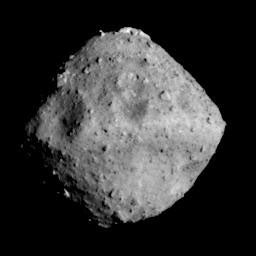The Independent's journalism is supported by our readers. When you purchase through links on our site, we may earn commission.
New samples from Japanese mission could prove Earth’s water came from asteroids
The Japanese mission has confirmed the asteroid Ryugu is an uncontaminated example of the type of asteroids that might have given Earth its water billions of years ago

Your support helps us to tell the story
From reproductive rights to climate change to Big Tech, The Independent is on the ground when the story is developing. Whether it's investigating the financials of Elon Musk's pro-Trump PAC or producing our latest documentary, 'The A Word', which shines a light on the American women fighting for reproductive rights, we know how important it is to parse out the facts from the messaging.
At such a critical moment in US history, we need reporters on the ground. Your donation allows us to keep sending journalists to speak to both sides of the story.
The Independent is trusted by Americans across the entire political spectrum. And unlike many other quality news outlets, we choose not to lock Americans out of our reporting and analysis with paywalls. We believe quality journalism should be available to everyone, paid for by those who can afford it.
Your support makes all the difference.The latest paper to come out of the Japanese Space Agency’s (Jaxa) sample return mission to the asteroid Ryugu offers more evidence to support a longstanding theory about where Earth got its water — namely, from asteroids like Ryugu.
“Volatile and organic-rich C-type asteroids may have been one of the main sources of Earth’s water,” the research team led by Yuichi Tsuda, project manager for Jaxa’s sample return mission, wrote in a paper published Monday in Nature Astronomy.
But, they continue, that theory is based primarily on carbonaceous chondritic meteorites that have fallen to Earth: “The meteorite record is biased: only the strongest types survive atmospheric entry and are then modified by interaction with the terrestrial environment.”
Planetary scientists believe that either asteroids or comets crashing into the infant Earth were responsible for providing our planet with its water. But the chemical makeup of comets doesn’t quite match what scientists would expect based on minerals found on Earth, according to an article on the Carnegie Institution for Science website.
Scientists theorise that large asteroids known as planetesimals, which are rich in volatiles such as hydrogen and water stored in clays, are a better chemical match as the source of Earth’s water. Many present-day asteroids like Ryugu could store material like that of primordial planetesimals held in a deep freeze.
The latest results of laboratory tests of material sampled from Ryugu and returned to Earth in December by Jaxa’s Hayabusa 2 mission confirm that Ryugu is a good example of the material formed in the early Solar System, typical of the asteroids from which carbonaceous chondritic meteorites were chipped off, but without alteration by Earth’s chemistry.
“Ryugu particles are the most uncontaminated and unfractionated extraterrestrial materials studied so far, and provide the best available match to the bulk Solar System composition,” the researchers write. For instance, while carbonaceous chondritic meteorites contain the minerals ferrihydrite and sulfate, researchers did not find those minerals in the Ryugu samples, “which indicates that these minerals in CI chondrites formed due to terrestrial weathering.”
After its rendezvous with Ryugu, Jaxa’s Hayabusa 2 mission sampled 5.4 grams of the 1 kilometer diameter near-Earth asteroid’s surface material using an impactor in 2019.
Laboratory analysis so far has not only shown Ryugu to be a good example of primordial Solar System material, and a possible, but has shown it contains the organic materials necessary for making DNA, raising the possibility that asteroids not only provided Earth with its water, but provided some of the building blocks of life as well.
Join our commenting forum
Join thought-provoking conversations, follow other Independent readers and see their replies
Comments